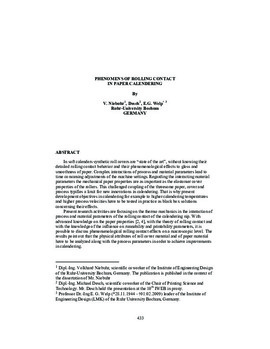| dc.contributor.author | Niebuhr, V. | |
| dc.contributor.author | Desch, M. | |
| dc.contributor.author | Welp, E. G. | |
| dc.contributor.other | International Conference on Web Handling (2009) | |
| dc.date.accessioned | 2019-11-11T19:52:42Z | |
| dc.date.available | 2019-11-11T19:52:42Z | |
| dc.date.issued | 2009-06 | |
| dc.identifier | oksd_icwh_2009_niebuhr | |
| dc.identifier.citation | Niebuhr, V., Desch, M., & Welp, E. G. (2009, June). Phenomens of rolling contact in paper calendering. Paper presented at the Tenth International Conference on Web Handling (IWEB), Stillwater, OK. | |
| dc.identifier.uri | https://hdl.handle.net/11244/321950 | |
| dc.description.abstract | In soft calenders synthetic roll covers are "state of the art", without knowing their detailed rolling contact behavior and their phenomenological effects to gloss and smoothness of paper. Complex interactions of process and material parameters lead to time consuming adjustments of the machine settings. Regarding the interacting material parameters the mechanical paper properties are as important as the elastomer cover properties of the rollers. This challenged coupling of the threesome paper, cover and process typifies a limit for new innovations in calendering. That is why present development objectives in calendering for example to higher calendering temperatures and higher process velocities have to be tested in practice as black box solutions concerning their effects. | |
| dc.description.abstract | Present research activities are focusing on the thermo mechanics in the interaction of process and material parameters of the rolling contact of the calendering nip. With advanced knowledge on the paper properties [2, 4], with the theory of rolling contact and with the knowledge of the influence on runnability and printability parameters, it is possible to discuss phenomenological rolling contact effects on a macroscopic level. The results point out that the physical attributes of roll cover material and of paper material have to be analyzed along with the process parameters in order to achieve improvements in calendering. | |
| dc.description.abstract | The investigated interactions motivate a new evaluation of the calendering process under consideration of mechanic, thermal, hygroscopic, visco-elastic and rolling contact effects. This point of view is close to reality and permits the detection of physical interactions in the calender nip. From these detected dependencies we can formulate conclusions to gloss and smoothness behavior as well as to the other printability and runnability parameters. | |
| dc.description.abstract | To reduce time consuming process optimization in production, precise details on optimal machine settings in the process can be delivered. Although details to paper and roll cover properties for calendering can be given by identifying the physical interactions in the rollers' nip. Knowledge of these interactions will reveal the basic calender processes. | |
| dc.format | application/pdf | |
| dc.language | en_US | |
| dc.publisher | Oklahoma State University | |
| dc.rights | In the Oklahoma State University Library's institutional repository this paper is made available through the open access principles and the terms of agreement/consent between the author(s) and the publisher. The permission policy on the use, reproduction or distribution of the article falls under fair use for educational, scholarship, and research purposes. Contact Digital Resources and Discovery Services at lib-dls@okstate.edu or 405-744-9161 for further information. | |
| dc.title | Phenomens of rolling contact in paper calendering | |
| osu.filename | oksd_icwh_2009_niebuhr.pdf | |
| dc.type.genre | Conference proceedings | |
| dc.type.material | Text | |
